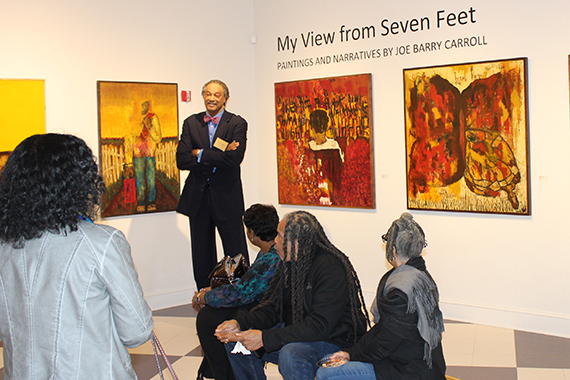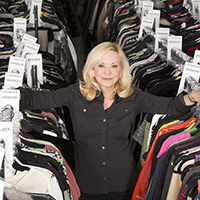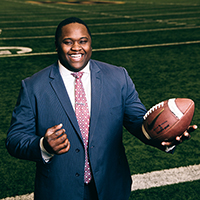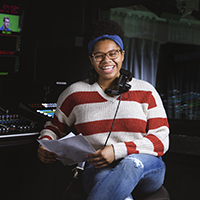 Boilermaker basketball legend and former NBA All-Star Joe Barry Carroll is today a wealth advisor, philathropist, painter, publisher and author. (Photo by Tara Coyt)
Boilermaker basketball legend and former NBA All-Star Joe Barry Carroll is today a wealth advisor, philathropist, painter, publisher and author. (Photo by Tara Coyt)
The Next Giant Leap
Purdue basketball legend balances career as a financial advisor with painting, writing and philanthropy
At seven-feet-tall, Purdue basketball legend and Krannert alumnus Joe Barry Carroll has taken a number of giant leaps in his life — from college athlete to NBA All-Star, from basketball player to wealth advisor, from art collector to artist, and from avid reader to author and publisher.
One of the nation’s top recruits, Carroll played at Purdue from 1976-1980 and is the only Purdue men’s basketball player to score a triple double, with 16 points, 16 rebounds and a school record 11 blocks. He led the Boilermakers to the NIT finals in his junior year, and the Final Four in his senior year when he was named a first team All-American.
Lofty achievements
Carroll, the tenth of 13 children, graduated from the Krannert School with a degree in economics. He was the No. 1 overall pick in the 1980 National Basketball Association Draft, selected by the Golden State Warriors.
During his first season with the Warriors, Carroll was selected NBA All-Rookie First Team Center and over the next seven seasons with Golden State he was a member of the NBA All Star Team (1987) and averaged more than 20 points per game. He regularly appeared in NBA playoff games over his 11-year professional career.
Upon retiring from the NBA in 1991, Carroll relocated to Atlanta, Georgia, and in 1993 founded the Carroll Group, a wealth advisory company serving professional athletes and other high-net-worth families.
“My clients have anywhere from $5 million to as much as $20 million in assets,” he says. “I help them preserve their wealth and approach the whole culture of wealth in what I hope is a more healthy and holistic way. I’m a client, too, so I have to stay on top of the research and understand everything for my own personal needs and requirements,” he says.
The Carroll Group’s practice is based on a wealth management model Carroll implemented while in the NBA and refined over the years. His approach to spending, saving, investing, philanthropy, and more will be featured in Carroll’s next book, scheduled to release later this year.
As a philanthropist, Carroll established the BroadView Foundation to financially support and participate in organizations and programs that work to make the world a better place for children, students, elderly, economically disadvantaged, and individuals and communities of color.
He also donates 100 percent of proceeds from his books and art to select local and national nonprofit organizations, including the ACLU, NPR, and Georgia Innocence Project. Carroll’s commitment to philanthropy was recognized with a “Hank Aaron Champion for Justice” award from the Atlanta Braves and the Center for Civil and Human Rights.
Artistic Visions
Carroll has also found a way to balance his “day job” as an investment advisor with his more creative work.
Speaking about his art Carroll says, “It also gives me a balance. I need these two things. In my studio, on one side it has a desk and computer screens and research and graphs and all of that. On the other side is an easel. I kind of toggle back and forth. It keeps me sane and healthy.”
Carroll’s long-held interest in the arts eventually inspired him to begin painting in his home studio. Early on he experimented with colorizing old family photographs and quickly graduated to painting and mixing materials — paint, fabric, newspaper and even coffee grounds found around the house, garage and elsewhere on his fifty-acre property.
Carroll uses paintings to tell stories. In his memoir Growing Up . . . In Words and Images, 70 of his acrylic and mixed materials paintings help tell the story of a young boy who was shaped and guided by the people and places he encountered growing up in the American south, "up north" in Denver, and eventually in the NBA. The paintings provide a visual of those who helped an impressionable and unsure boy discover his strengths and weaknesses and influenced his decision to make a positive impact on the world.
Carroll released his second book, Black American Voices: Shared Culture, Values, and Emotions, in 2017. In addition to numerous literary appearances, his work has been exhibited at the Historic Arkansas Museum, Purdue University, and the Lafayette Museum of Art.
The latter book recently spawned an exhibit that features 32 African art objects from the Antonio and Betty Zamora Collection of African Art displayed alongside snapshots and family photos of black Americans as well as personal narratives. The collection of uplifting narratives, and striking photographs of Black Americans and African art draws an indelible connection between the American experience and African culture. The narratives are real-life stories relayed to Carroll by family, friends, and other memorable people he has met over the years.
My View from Seven Feet, released in 2020, is Carroll's musing on the mythical qualities some are want to assign to a person standing seven feet tall. The “view” refers to the collage and accumulation of his observations, thoughts, and feelings. They are presented in the form of narratives and paintings, combined to tell a story.
Carroll says, "What flows from my pen and brush feels natural to me. I am never sure if the images create words, or the words move me to images. I am unable to tell precisely what determines my composition of colors, shapes and themes. Perhaps everything is forming at the same time, resulting in a complete story."
Sharing stories is important to Carroll, which is why he established Joe Barry Carroll Publishing several years ago. One of those stories, Coach Lee Rose: On Family and Basketball, was also released in 2020. Carroll was the ghost writer for this memoir about Coach Rose, who took Purdue to the Final Four in 1980.
Although he’s still mostly known for his accomplishments on the court, Carroll doesn’t “separate it out” from his post-basketball career.
“Historically, there’s been a taint on the intellectual side for basketball players and entertainers or whatever,” he says. “I’m a jock. I embrace my legacy, I was a jock, I’m still a jock and I’m an artist and I’m a businessman and entrepreneur, philanthropist and all of that stuff too. It’s all an ‘and’ for me. I’m not trying to replace that because whatever that was, I’m fine with it. It’s included.”











